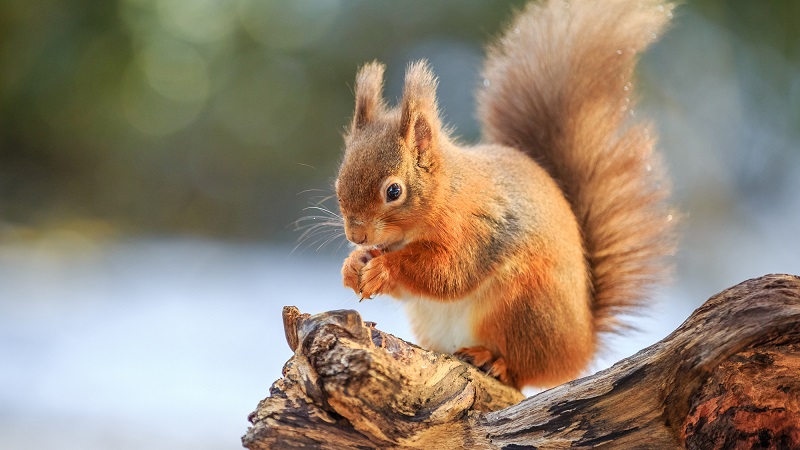Published:

New research and a five-year study of red squirrel behaviour indicates that conservation efforts targeting one of Scotland's most-loved species needs a rethink.
A report from Heriot-Watt University, Forestry and Land Scotland (FLS) and the University of the Highlands and Islands (UHI) Inverness indicates that red squirrel populations are viable in landscapes managed for timber under the UK Forestry Standard and that current special protection measures are ineffective and should be relaxed.
Further development of mathematical ecology models by Heriot-Watt's Professor Andy White also suggests that work on squirrel strongholds, which is currently focused on areas where greys are absent, would be more effective if it were instead focused on areas where grey squirrels pose a danger, such as south of the central belt or in lower Tayside.
FLS's wildlife ecologist Kenny Kortland said: “Red squirrel habitat includes Scotland's productive forests and it has long been a challenge for foresters to balance the production of timber with the legal duty to protect red squirrels.
“This latest research with ecologists and modellers shows that commercial forestry isn't a threat to red squirrels and that, when managed carefully, forestry plantations can be great habitats for red squirrels.
“For example, work that UHI has done over the past five years to track squirrel movement before and after thinning operations found no detrimental impact on red squirrel breeding activity or survival. In fact, population density was higher after the operations. The only measurable impact was a slight shift in space use for a couple of individual squirrels, which was likely due to food availability.
“This suggests that there are probably better management tactics from both the forester and the squirrel's point of view.
“It would also mean that much of the £100k upwards that is currently spent annually on red squirrel management measures could be more effectively channelled to other conservation efforts.”
The team's research indicates that while special management measures (the right tree species mix and age structure) are required where grey squirrels are also present, in areas without grey squirrels some red squirrel protection measures, such as drey surveys, are ineffective and could be relaxed.
Tree felling operations almost always result in members of the public contacting forest managers with concerns about the impact of tree felling on their local red squirrels.
As well as the need to make use of evidence-based and targeted protection measures, red squirrel behaviour and adaptability should also inform decisions on when forests are felled, and how.
Currently, operations in important squirrel forests are scheduled to avoid the breeding season and felling work will often be postponed if pre-operational surveys find dreys.
Site-specific mitigation can include retaining drey trees and felling in such a way as to make it as easy as possible for squirrels to relocate into adjacent crops.
Dr Louise de Raad, formerly a research fellow at UHI Inverness, said: “Since 2017, FLS and UHI Inverness have been studying how red squirrels respond to tree felling by fitting squirrels with radio collars and tracking their movements before, during and after the tree-felling work.
“When we combined the tracking results with drey survey returns we found that the survey missed over 80% of dreys that were actually used by red squirrels.
“It's clearly not an effective mitigation to leave identified drey trees and it would be better to focus on other methods – such as looking for signs such as chewed cones, for example – that only indicate the presence or absence of red squirrels in a forest.
“What we also found was that red squirrels are well-adapted to dispersing within and between forest blocks and being able to cope with forestry activity. They can move out of the way when the work is being done.
“When there is adjacent suitable habitat available for red squirrels to disperse to, standard thinning and felling operations seem to have no significant impact on their survival or breeding success.”
“We must continue to protect red squirrels, but we need to review the current mitigation strategies to make sure we do this in the most effective way.”
Red squirrel behaviour is highly flexible in these conifer habitats and individuals adapt their space use to seasonal and annual changes in food availability. When a cone crop fails naturally in one year, they simply relocate.
Further research carried out by Professor Andy White, a mathematical ecologist in Heriot-Watt's School of Mathematical and Computer Science, and squirrel expert Dr Peter Lurz suggests that management of Scotland's 19 designated red squirrel strongholds also needs to be reviewed.
The stronghold forests have been altered, by removing or not planting the broadleaf species preferred by greys, to favour red squirrels and prevent greys from moving in. However, the modelling questions whether focusing on these areas is an effective strategy.
Professor White said: “Many of the current 19 strongholds are in regions where the greys are absent. So the time and money spent modifying these forests to better prepare reds for the impacts of grey competition may have little additional benefit.
“Even in a worst-case scenario of grey squirrel invasion, there are large forested regions where the tree species present would support the reds but would be unfavourable to greys. Clearly, these areas would not require specific management by foresters."
“It does suggest that the stronghold programme would be more effective if it were adapted to where greys pose a danger, such as south of the central belt or in lower Tayside.”